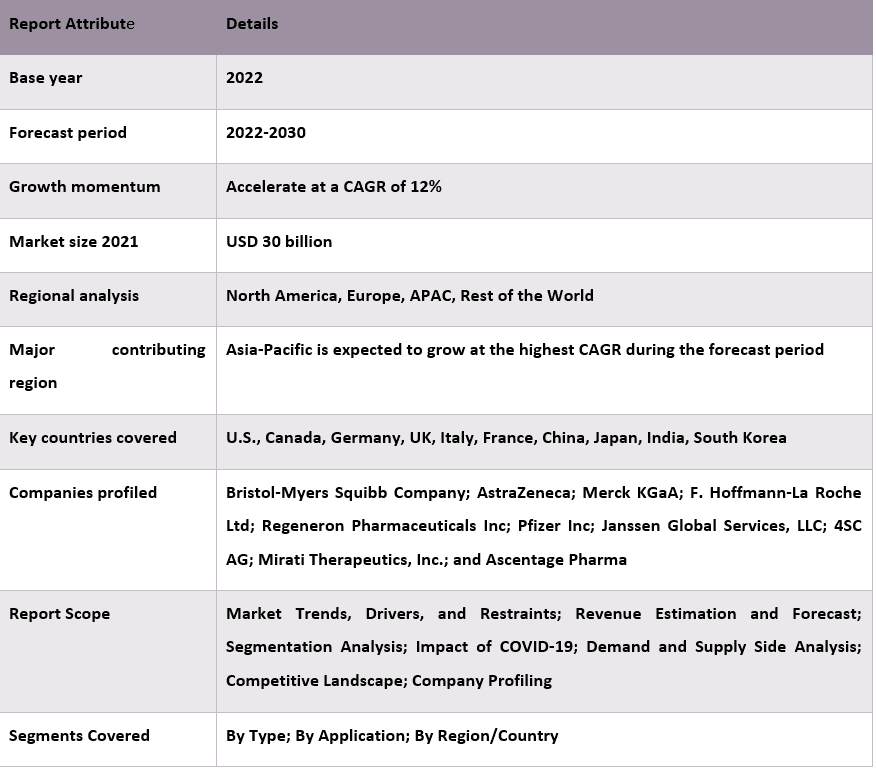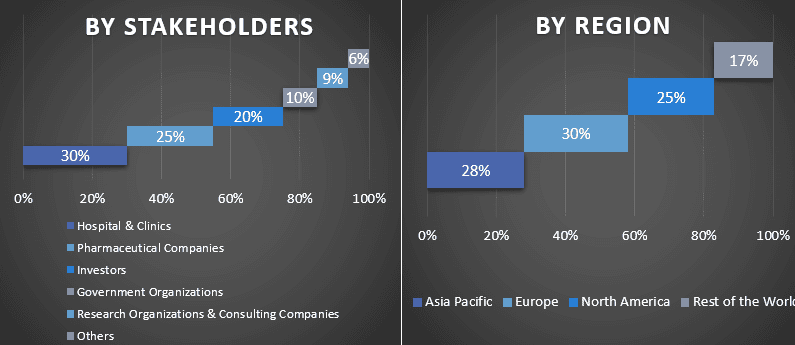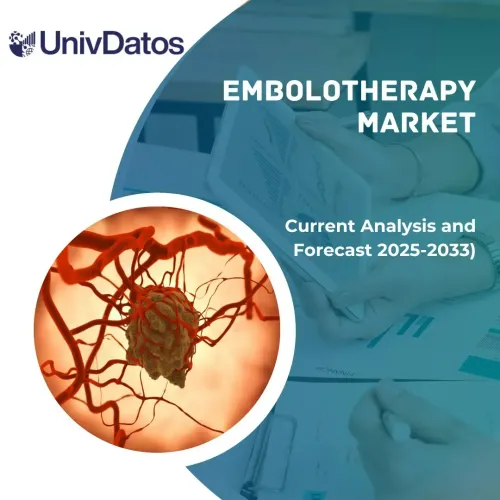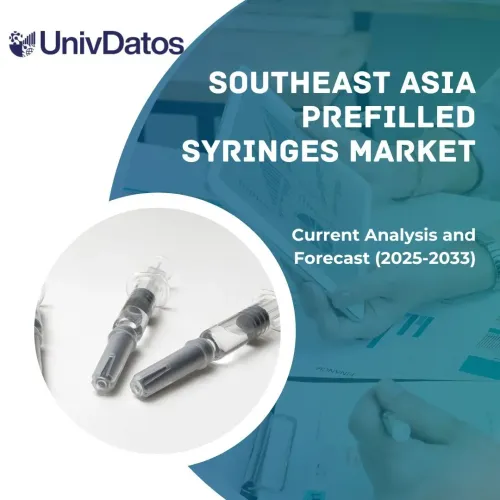- Home
- About Us
- Industry
- Services
- Reading
- Contact Us
Checkpoint Inhibitor Refractory Cancer Market: Current Analysis and Forecast (2023-2030)
Emphasis on Type (PD-1 Inhibitor, PD-L1 Inhibitor, and Others); Application (Lung Cancer, Bladder Cancer, Melanoma, Hodgkin Lymphoma, and Others); and Region/Country

The Checkpoint Inhibitor Refractory Cancer market held 30 billion in 2022 is expected to grow at a strong CAGR of around 12% during the forecast period (2023-2030). Checkpoint inhibitor refractory cancer refers to cancer that has failed to respond to treatment with checkpoint inhibitors. Checkpoint inhibitors are a type of cancer treatment that works by inhibiting the activity of immune checkpoints, which are proteins that regulate the immune system and prevent it from attacking healthy cells. Checkpoint inhibitors are a type of personalized cancer treatment and the increasing demand for personalized cancer treatments, as they are tailored to an individual’s specific cancer and genetic makeup is the important factor driving the growth of the checkpoint inhibitor refractory cancer market.
Some of the major players operating in the market are Bristol-Myers Squibb Company; AstraZeneca; Merck KGaA; F. Hoffmann-La Roche Ltd; Regeneron Pharmaceuticals Inc; Pfizer Inc; Janssen Global Services, LLC; 4SC AG; Mirati Therapeutics, Inc.; and Ascentage Pharma. Several M&As along with partnerships have been undertaken by these players to facilitate customers with hi-tech and innovative products/technologies.
Insights Presented in the Report
“Amongst type, the semi-synthetic segment is expected to grow at a higher CAGR during the forecast period.”
Based on type, the market is segmented into PD-1 inhibitor, PD-L1 inhibitor, and others. As per our analysis, the PD-L1 inhibitor segment is expected to grow at a high CAGR during the forecast period. PD-L1 inhibitors are a type of immunotherapy that works by blocking the interaction between PD-L1 and its receptor on T cells. This allows T cells to attack and kill cancer cells that express PD-L1. Due to the fast action and high efficiency of the treatment the segment is expected to grow at a fast rate in the checkpoint inhibitor refractory cancer market.
“Amongst applications, the pain management segment held the dominant share in 2021.”
Based on the application, the market is segmented into lung cancer, bladder cancer, melanoma, Hodgkin lymphoma, and others. As per our analysis, the lung cancer segment held the dominant share in 2021. Lung cancer is the second most prevalent cancer and the increasing cases of the cancer is the major attributing for the dominating share of the segment in the checkpoint inhibitor refractory cancer market. For instance, as per the Globocan 2020, 2.2 million new cases of lung cancer were reported in 2020 globally.
“Asia Pacific is expected to grow with the highest CAGR Checkpoint Inhibitor Refractory Cancer market during the forecast period.”
Asia Pacific is expected to grow with the highest CAGR checkpoint inhibitor refractory cancer market during the forecast period. The rapidly rising population, along with the increasing research efforts for the cancer treatment in the region is attributed to the market growth of checkpoint inhibitor refractory cancer in Asia-Pacific. For instance, Calico Life Sciences LLC is conducting Phase 1 trial for open label human study with ABBV-CLS-579 alone and in combination in subjects with locally advanced or metastatic tumors in Japan and other nations.
Checkpoint Inhibitor Refractory Cancer Market Report Coverage

Reasons to buy this report:
- The study includes market sizing and forecasting analysis validated by authenticated key industry experts.
- The report presents a quick review of overall industry performance at one glance.
- The report covers an in-depth analysis of prominent industry peers with a primary focus on key business financials, product portfolios, expansion strategies, and recent developments.
- Detailed examination of drivers, restraints, key trends, and opportunities prevailing in the industry.
- The study comprehensively covers the market across different segments.
- Deep dive regional level analysis of the industry.
Customization Options:
The global checkpoint inhibitor refractory cancer market can further be customized as per the requirement or any other market segment. Besides this, UMI understands that you may have your own business needs, hence feel free to connect with us to get a report that completely suits your requirements.
Table of Content
Research Methodology for the Checkpoint Inhibitor Refractory Cancer Market Analysis (2023-2030)
Analyzing the historical market, estimating the current market, and forecasting the future market of the global checkpoint inhibitor refractory cancer market were the three major steps undertaken to create and analyze the adoption of Checkpoint Inhibitor Refractory Cancer in major regions globally. Exhaustive secondary research was conducted to collect the historical market numbers and estimate the current market size. Secondly, to validate these insights, numerous findings and assumptions were taken into consideration. Moreover, exhaustive primary interviews were also conducted, with industry experts across the value chain of global checkpoint inhibitor refractory cancer market. Post assumption and validation of market numbers through primary interviews, we employed a top-down/bottom-up approach to forecasting the complete market size. Thereafter, market breakdown and data triangulation methods were adopted to estimate and analyze the market size of segments and sub-segments of the industry pertains to. Detailed methodology is explained below:
Analysis of Historical Market Size
Step 1: In-Depth Study of Secondary Sources:
Detail secondary study was conducted to obtain the historical market size of the checkpoint inhibitor refractory cancer market through company internal sources such as annual reports & financial statements, performance presentations, press releases, etc., and external sources including journals, news & articles, government publications, competitor publications, sector reports, third-party database, and other credible publications.
Step 2: Market Segmentation:
After obtaining the historical market size of the checkpoint inhibitor refractory cancer market, we conducted a detailed secondary analysis to gather historical market insights and share for different segments & sub-segments for major regions. Major segments are included in the report as type and application. Further country-level analyses were conducted to evaluate the overall adoption of testing models in that region.
Step 3: Factor Analysis:
After acquiring the historical market size of different segments and sub-segments, we conducted a detailed factor analysis to estimate the current market size of the checkpoint inhibitor refractory cancer market. Further, we conducted factor analysis using dependent and independent variables such as type and application of the checkpoint inhibitor refractory cancer market. A thorough analysis was conducted for demand and supply-side scenarios considering top partnerships, mergers and acquisitions, business expansion, and product launches in the checkpoint inhibitor refractory cancer market sector across the globe.
Current Market Size Estimate & Forecast
Current Market Sizing: Based on actionable insights from the above 3 steps, we arrived at the current market size, key players in the global checkpoint inhibitor refractory cancer market, and market shares of the segments. All the required percentage shares split, and market breakdowns were determined using the above-mentioned secondary approach and were verified through primary interviews.
Estimation & Forecasting: For market estimation and forecast, weights were assigned to different factors including drivers & trends, restraints, and opportunities available for the stakeholders. After analyzing these factors, relevant forecasting techniques i.e., the top-down/bottom-up approach were applied to arrive at the market forecast for 2030 for different segments and sub-segments across the major markets globally. The research methodology adopted to estimate the market size encompasses:
- The industry’s market size, in terms of revenue (USD) and the adoption rate of the Checkpoint Inhibitor Refractory Cancer market across the major markets domestically
- All percentage shares, splits, and breakdowns of market segments and sub-segments
- Key players in the global checkpoint inhibitor refractory cancer market in terms of products offered. Also, the growth strategies adopted by these players to compete in the fast-growing market
Market Size and Share Validation
Primary Research: In-depth interviews were conducted with the Key Opinion Leaders (KOLs) including Top Level Executives (CXO/VPs, Sales Head, Marketing Head, Operational Head, Regional Head, Country Head, etc.) across major regions. Primary research findings were then summarized, and statistical analysis was performed to prove the stated hypothesis. Inputs from primary research were consolidated with secondary findings, hence turning information into actionable insights.
Split of Primary Participants in Different Regions

Market Engineering
The data triangulation technique was employed to complete the overall market estimation and to arrive at precise statistical numbers for each segment and sub-segment of the global checkpoint inhibitor refractory cancer market. data was split into several segments & sub-segments post studying various parameters and trends in the areas of the type and application in the global checkpoint inhibitor refractory cancer market.
The main objective of the Global Checkpoint Inhibitor Refractory Cancer Market Study
The current & future market trends of the global checkpoint inhibitor refractory cancer market were pinpointed in the study. Investors can gain strategic insights to base their discretion for investments on the qualitative and quantitative analysis performed in the study. Current and future market trends determined the overall attractiveness of the market at a regional level, providing a platform for the industrial participant to exploit the untapped market to benefit from a first-mover advantage. Other quantitative goals of the studies include:
- Analyze the current and forecast market size of the checkpoint inhibitor refractory cancer market in terms of value (USD). Also, analyze the current and forecast market size of different segments and sub-segments
- Segments in the study include areas of type and application.
- Define and analysis of the regulatory framework for the checkpoint inhibitor refractory cancer industry
- Analyze the value chain involved with the presence of various intermediaries, along with analyzing customer and competitor behaviors of the industry
- Analyze the current and forecast market size of the checkpoint inhibitor refractory cancer market for the major region
- Major countries of regions studied in the report include Asia Pacific, Europe, North America, and the Rest of the World
- Company profiles of the checkpoint inhibitor refractory cancer market and the growth strategies adopted by the market players to sustain in the fast-growing market
- Deep dive regional level analysis of the industry
Related Reports
Customers who bought this item also bought










